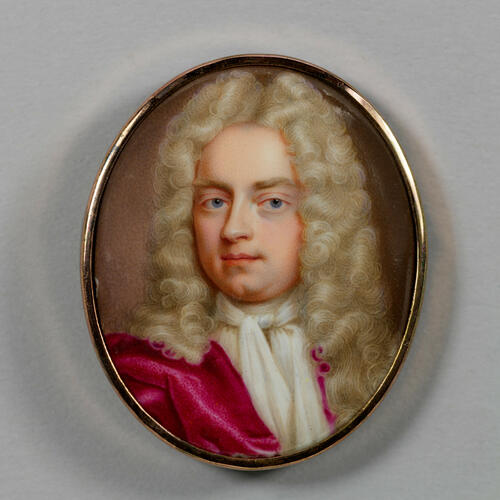-
1 of 253523 objects
Joseph Addison (1672-1719) c.1715
Enamel | 3.6 x 2.9 cm (sight) (sight) | RCIN 421424
-
Joseph Addison was a poet, classical scholar, author and Member of Parliament holding various offices of state. He was the son of Lancelot Addison, vicar of Milston, and his wife, Jane. At 13, he was sent to Charterhouse school and there met Richard Steele, who was to become a life-long friend and with whom he later wrote essays for The Tatler, The Spectator and The Guardian. Both went to Oxford where, at Magdalen College, Addison's Walk commemorates his habit of strolling in the park surrounding the college. When Queen Anne died in 1714, Addison's duties included supervising the arrangements for the Queen's funeral and the new King's arrival. He married Charlotte Rich, Countess of Warwick, in 1716. Addison came to be regarded as one of the most eminent writers of the time. His essays were very widely read and very influential, both at home and abroad and were admired for their progressive tone, and for their humour, warmth and good sense. He claimed in The Spectator that he had 'brought Philosophy out of Closets and Libraries, schools and Colleges, to dwell in Clubs and Assemblies, at Tea-Tables and in Coffee-Houses'.
The artist, Christian Frederick Zincke (1683/4-1767), was born in Dresden, the son of a goldsmith. He settled in England in 1706 and studied enamel painting under Charles Boit. Boit was Enamel Painter to the Court until Queen Anne died in 1714 when he moved to France and Zincke took over much of his work. Zincke developed a thriving business, at first copying portraits by Sir Peter Lely and Sir Godfrey Kneller, then painting from life. He worked extensively for the royal family and, perhaps because he spoke German, was one of the few artists George II could tolerate. By 1730 he was well established at court and in February 1732, was appointed Cabinet Painter to Frederick, Prince of Wales, George II's eldest son. His eyesight began to fail, however, and he lamented: 'I find my Eyes scarce Capable of seeing them fine strokes'. By 1752 he had retired and only painted for his own pleasure. George II commented that Zincke's portraits were 'beautiful and like'. This enamel by Zincke was almost certainly painted from life around 1715.Provenance
Bought by George III from Rundell and Bridge, 30 November 1799
-
Medium and techniques
Enamel
Measurements
3.6 x 2.9 cm (sight) (sight)
3.8 x 3.2 cm (frame, external)
Other number(s)
RL 1885 109
